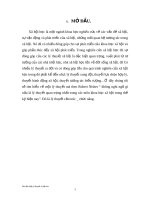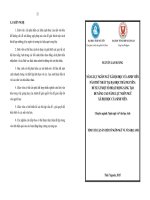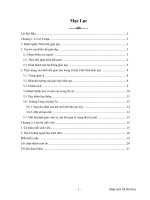TIỂU LUẬN NGÔN NGỮ XÃ HỘI HỌC
Bạn đang xem bản rút gọn của tài liệu. Xem và tải ngay bản đầy đủ của tài liệu tại đây (242.65 KB, 10 trang )
HUE UNIVERSITY
INSTITUTE OF OPEN EDUCATION
AND INFORMATION TECHNOLOGY
ENGLISH LANGUAGE
🙤🙤🙤
SOCIOLINGUISTIC PROJECT
Lecturer: PhD.Trần Thuần
Student: Nguyễn Hoàng Anh
Student’s code: 7052900485
Class: Nghệ An 6
TOPIC 2: Examine the differences between the English
spoken in Boston and the English spoken in the
southern area of the United States. Why do you think
there are such dialectal evidence?
Nghệ An, 7/2023
1
I. Introduction
The English spoken in Boston, Massachusetts, and the English spoken in the
southern area of the United States exhibit notable dialectal differences. These
variations in pronunciation, vocabulary, grammar, and intonation can be
attributed to historical, geographical, and cultural factors. Let's examine these
differences and explore the reasons behind the dialectal evidence:
II. Pronunciation
Pronunciation differences between the English spoken in Boston and the
English spoken in the southern area of the United States are significant and
distinguishable. These variations in pronunciation reflect the unique accents
and speech patterns of each region. Let's explore some of the key
pronunciation differences:
2.1. Rhoticity:
- Boston: The Boston accent is non-rhotic, meaning that the "r" sound is often
not pronounced at the end of syllables or words. This is known as "r-dropping."
For example, the word "car" may be pronounced as "cah" or "pahty" for
"party."
- Southern U.S.: In the southern accent, the "r" sound is typically pronounced in
all positions, making it rhotic. Words ko like "car" would be pronounced with
the "r" sound fully pronounced.
2.2. Vowel Sounds:
- Boston: The Boston accent exhibits distinct vowel sounds. The "a" sound in
words like "cat" and "trap" is often pronounced with a raised tongue, resulting
2
in a sound similar to "æ" as in "cat" or "æɪ" as in "face." The "o" sound in words
like "caught" and "cot" is usually merged to a single vowel sound.
- Southern U.S.: The southern accent has its own vowel sound variations. It
often features a longer and more drawn-out pronunciation of certain vowels,
such as the "a" sound in words like "cat" and "trap," which may be pronounced
with a more open and rounded quality.
2.3. Intonation and Rhythm:
- Boston: The Boston accent has a distinct intonation pattern and speech
rhythm. It is characterized by a rising intonation, where the pitch rises at the
end of sentences, even in declarative statements. This pattern gives the
impression of asking a question, known as "Bostonian rising."
- Southern U.S.: The southern accent has a slower pace and a melodic quality. It
often features a relaxed and rhythmic speech pattern, with certain syllables
elongated and an overall drawl in pronunciation.
2.4. Consonant Sounds:
- Boston: The Boston accent may exhibit certain consonant sound variations.
The "r" sound is often dropped or softened, but it can appear in other
positions, such as the beginning of words. Additionally, the "t" sound may be
pronounced as a softer "d" sound in certain contexts.
- Southern U.S.: The southern accent may have its own consonant sound
variations, including a more pronounced "r" sound in all positions. Certain
consonants, such as "d" and "t," may have a softer or more aspirated
pronunciation, particularly in word-final positions.
III. Vocabulary
3
Vocabulary differences between the English spoken in Boston and the English
spoken in the southern area of the United States reflect regional influences,
cultural practices, and historical factors. These variations in vocabulary
contribute to the distinct flavor of each regional dialect. Let's explore some
notable vocabulary differences:
3.1. Food Terminology:
- Boston: The Boston dialect incorporates unique food terms influenced by local
culinary traditions. For example, "grinder" is used to refer to a submarine
sandwich or a hoagie, and "jimmies" are used to refer to chocolate or rainbow
sprinkles.
- Southern U.S.: The southern dialect may have its own set of food terminology
influenced by regional cuisine. Terms like "biscuit" refer to a type of bread roll,
and "grits" are a corn-based dish commonly eaten for breakfast.
3.2. Expressions and Colloquialisms:
- Boston: The Boston dialect includes expressions and colloquialisms specific to
the region. For example, "wicked" is used as an intensifier to mean "very," as in
"wicked good." "Pisser" is used to describe something that is funny or amusing.
- Southern U.S.: The southern dialect has its own set of expressions and
colloquialisms. Terms like "y'all" are used as a second-person plural pronoun,
and "bless your heart" may be used as a polite way of expressing sympathy or
consolation.
3.3. Regional Terminology:
4
- Boston: The Boston dialect incorporates terminology specific to the region.
For example, "rotary" is used to refer to a traffic circle, "Packie" is short for
"package store" or liquor store, and "bang a uey" means to make a U-turn.
- Southern U.S.: The southern dialect may have its own regional terminology.
For instance, "fixin' to" means "getting ready to" or "about to," and "holler" is
used to describe a small, remote, or rural area.
3.4. Cultural References:
- Boston: The Boston dialect may include vocabulary related to local cultural
references and historical events. For example, terms like "Fenway" refer to
Fenway Park, the famous baseball stadium, and "the Big Dig" refers to the
extensive highway construction project in Boston.
- Southern U.S.: The southern dialect incorporates vocabulary related to
regional cultural references. Terms like "the Bible Belt" refer to the
predominantly religious and conservative areas of the southern U.S., and
"Mardi Gras" refers to the festive celebration in New Orleans.
3.5. Specific Industries or Activities:
- Boston: The Boston dialect may have vocabulary specific to industries or
activities prominent in the region. For example, terms like "pahk the cah" are
associated with the local sports culture, referring to parking a car.
- Southern U.S.: The southern dialect may include vocabulary related to
industries or activities prevalent in the region, such as agricultural terms like
"cotton-pickin'" to emphasize frustration or annoyance.
These vocabulary differences between the English spoken in Boston and the
English spoken in the southern area of the United States reflect the influence of
regional culture, history, and linguistic interactions. They contribute to the
5
richness and diversity of the English language and highlight the unique
characteristics of each regional dialect.
IV. Grammar and Syntax
- Boston English: Drop of the auxiliary "to be": In certain contexts, speakers of
Boston English omit the auxiliary "to be" in present tense constructions. This
linguistic feature is known as "contracted be." For example, "She is going"
becomes "She going." This phenomenon can be traced back to the influence of
the Irish language, which lacks a distinct present tense form of the verb "to be”.
Use of double modals: Boston English employs double modals, such as "might
could" or "might should," to express possibility or uncertainty. This usage can
be attributed to the region's historical contact with dialects that exhibit similar
features, such as Appalachian English. The usage of double modals in Boston
English is a distinctive grammatical trait that sets it apart from other dialects.
- Southern American English: Use of "be" for ongoing actions: Southern
American English often uses the construction "be + verb" to convey ongoing
actions. For instance, "She be working" indicates continuous present action.
This usage can be traced back to the influence of African American Vernacular
English (AAVE), which has had a significant impact on Southern dialects. The
"be" construction in Southern American English is a remnant of the African
languages' habitual aspect, which is preserved in AAVE and adopted by
Southern speakers. Negative concord: Southern dialects frequently employ
double negatives for emphasis, such as "I don't know nothing." This usage
deviates from standard English grammar rules, but it is a common feature in
many Southern dialects. The use of negative concord can be traced back to the
influence of various non-standard dialects spoken in the region, including
Scots-Irish dialects and African American English.
6
V. Historical and Cultural Influences.
- Boston English: Irish immigration: The significant influx of Irish immigrants in
Boston during the 19th century left a lasting impact on the local dialect. The
Irish immigrants brought their own speech patterns, vocabulary, and
pronunciation, which merged with the existing linguistic landscape of Boston.
The non-rhotic pronunciation and vocabulary influenced by Irish terms and
expressions are direct evidence of the Irish influence on Boston English. Puritan
influence: Boston's history as a Puritan settlement during the colonial period
also contributed to the development of linguistic features in Boston English.
The Puritans held strong religious and cultural beliefs, which influenced
language use. Their linguistic conservatism and the preservation of archaic
grammatical structures can be observed in certain aspects of Boston English.
- Southern American English: Colonial settlement and slavery: The settlement
of English colonies in the South, along with the institution of slavery, played a
significant role in shaping the linguistic landscape of Southern American
English. The English spoken by early settlers in the Southern colonies, who
hailed from diverse regions in England, established the foundation of Southern
dialects. The interaction between English and African languages, particularly
during the period of slavery, led to the emergence of unique vocabulary,
pronunciation patterns, and grammatical features in Southern American
English. Agrarian society and isolation: The agrarian economy of the Southern
region, characterized by large plantations and isolated communities,
contributed to the preservation of linguistic features in Southern American
English. The agricultural lifestyle, with limited mobility and interaction with
speakers of other dialects, allowed the dialect to develop and evolve
independently. The isolation of Southern communities further solidified distinct
7
linguistic patterns, including vocabulary choices, pronunciation variations, and
grammatical structures.
VI. Socio-cultural Factors
- Boston English: Higher education and intellectual influence: Boston is
renowned for its prestigious universities and academic institutions, such as
Harvard and MIT. The presence of these institutions has had a significant
impact on the language use in the area. The influence of higher education and
intellectual discourse has contributed to a more formal and educated variant of
Boston English. The use of standardized grammar and vocabulary, as well as a
focus on clarity and precision in communication, can be observed in the speech
of educated Bostonians. Influence of the working-class population: Boston's
working-class population, known for its strong sense of community and local
pride, has played a role in shaping the dialect. The working-class dialect of
Boston English exhibits unique vocabulary choices and pronunciation patterns
that reflect the cultural values and social identity of the working-class
communities in the area. These linguistic features have been passed down
through generations and contribute to the distinct character of Boston English.
- Southern American English: Deep-rooted traditions and values: The Southern
region is known for its deep-rooted traditions, including hospitality, politeness,
and a strong sense of social hierarchy. These cultural values influence the
language use in the region. The slower speech pattern, the use of honorifics
and respectful terms, and the overall politeness of Southern American English
can be attributed to the influence of Southern traditions and values. Influence
of African American culture: African American culture has had a profound
influence on the development of Southern American English, particularly in
urban areas with significant African American populations. African American
8
Vernacular English (AAVE) has influenced vocabulary, pronunciation, and
grammatical structures in Southern dialects. The linguistic features of AAVE,
such as unique vocabulary items, pronunciation patterns, and grammatical
constructions, have permeated Southern American English, especially in African
American communities, reflecting the rich linguistic and cultural heritage of
African Americans in the region.
VII. Reasons for Dialectal Evidence:
Historical Settlement Patterns: The dialectal differences can be traced back to
the different historical settlement patterns in Boston and the southern region.
Boston has a history of early English colonization, with influences from Irish,
Italian, and other European immigrant groups. The southern area of the United
States, on the other hand, experienced settlement by English speakers from
various regions, including England, Scotland, Ireland, and West Africa.
Isolation and Regional Identity: Boston and the southern U.S. developed in
relative isolation from each other, leading to the preservation of distinct
dialectal features. The regional identity and cultural pride associated with these
dialects further contribute to their persistence.
Geographic and Social Factors: Geographical features and social interactions
also play a role. Boston's proximity to the sea and its historic importance as a
trade hub attracted diverse linguistic influences. The southern U.S., with its
agricultural and rural history, developed its own linguistic features influenced
by regional customs and cultural practices.
Cultural Heritage and Migration: Cultural heritage and patterns of migration
have impacted the dialects in each region. Boston's dialect reflects its colonial
and immigrant history, while the southern U.S. dialect incorporates elements
from Scottish, Irish, African American, and Native American influences.
9
In summary, the differences between the English spoken in Boston and the
English spoken in the southern area of the United States stem from historical,
geographical, and cultural factors. Settlement patterns, isolation, regional
identity, geography, and migration have all contributed to the development
and persistence of distinct dialectal features in these regions. The dialectal
evidence serves as a testament to the rich linguistic diversity within the English
language and the impact of regional influences on language variation.
10









